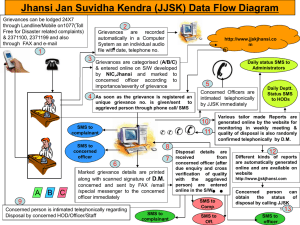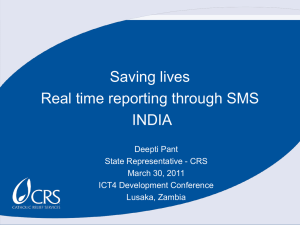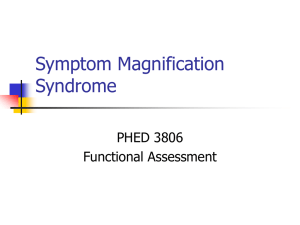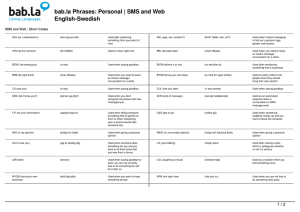Early warning system through SMS
advertisement
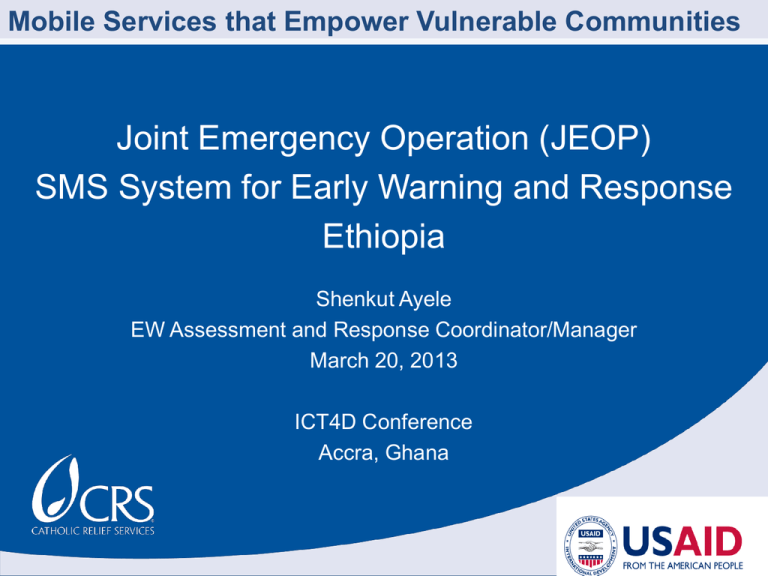
Mobile Services that Empower Vulnerable Communities Joint Emergency Operation (JEOP) SMS System for Early Warning and Response Ethiopia Shenkut Ayele EW Assessment and Response Coordinator/Manager March 20, 2013 ICT4D Conference Accra, Ghana JEOP Background • USAID funded emergency food assistance program providing food aid to 984,211 people (August 2012-July 2014) • Operational in 79 districts across 6 regions through consortium members in collaboration with GoE/DRMFSS • Program innovations include SILC, Behavior Change Communication (on improved use of supplemental blended food to prevent malnutrition) and EWS/SMS systems • Previous JEOP EWS (2010 – 2012) faced specific issues: • Generating timely, reliable, complementary and qualitative data for decision-making • Timely reporting for effective response • Real time Data & reporting could only be addressed through ICT4D JEOP operation areas: ICT4D Solution To address the challenges identified, JEOP designed a Participatory Early Warning and Response System using SMS • HNI – DataWinners Software • Building the SMS System with online training from HNI (via Skype) • Information from the field/districts sent to a database • Real timely data via Weekly SMS collected and uploaded on DataWinners Database (web based) • Training of SMS data Senders and Govt staff of each District & members of District EW committees • EW Coordinator and Focal Persons per JEOP Partners ICT4D Solution (Cont.) Data Collection & Information Flow Export of Data from Database to Excel Data Analysis with use of IPC and Reporting (Monthly Updates) Data Transfer to Database (CRS) Mobile Phone #: Data Receiver (CRS) • • • • • Mobile Phones/SMS – Data Sender Data collection with tools/ Copy of information to District EW Office Sources of EW information/District Level • • • • USAID Federal Gov Regional Gov District Gov JEOP Consortium Members FEWSNET WFP Community EW committee Other Partners Key Successes • 71/79 JEOP Operational districts covered • Timely reporting on 24 key indicators (previously 16) • Coordination/Complementarity • Effective communication/Transparency • Sharing of information with donors & partners • Learning/Innovation • Linking EW Data to Targeting/Actions/Forecasting and Planning (call forward requests/Pipelines) • Monthly EW updates • Better understanding the food insecurity situation of districts • SMS senders learned and adopted the system • Data exportation to excel Key Issues / Challenges • More robust data analysis and export from Database • Filtering data with more query options • Synchronization with GoE EWS • Production of graphs (by district/crops/price etc…) • Maps , Tables (by district/crops/price etc…) • Exporting Data to other software applications such as SPSS Lessons Learned • Vulnerable communities are both sources and receivers of EW information • District officials have more voice to represent the vulnerable community to higher levels of government • Improved food aid beneficiary targeting can help districts meet needs • Through the lesson learning forum, JEOP’s SMS system has been identified as a key contributing factor for the complementarity/coordination of the national EW and response system • The SMS system has the potential for different purposes accommodative capacity • Regional officials and partners expressed their interest to adopt the SMS system for more wider purpose Summary and Close • SMS is a key solution to Early Warning and Response to address food insecurity in Ethiopia • It is generating quality and accurate real time EW data from JEOP districts • JEOP management and stakeholders use the EW data for resource planning and to trigger response • GoE and USAID are very interested in the results achieved by JEOP in rolling out a similar system at national level.


